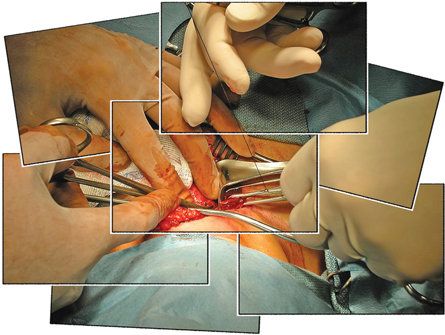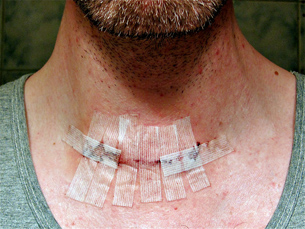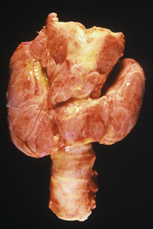Module 2
1. Module 2
1.29. Page 3
Module 2—The Endocrine System
The Thyroid Gland and Metabolism
 Read
Read
metabolism: all of the chemical reactions that occur in living organisms to support and sustain life processes
One type involves the buildup or synthesis of complex compounds from simple ones. A second type consists of the breakdown or decomposition of complex compounds into simple ones. Cellular respiration is one of the major metabolic processes.
cellular respiration: a process occurring outside and inside the mitochondria of cells of all living organisms in which energy-rich compounds, such as carbohydrates (glucose), proteins, and fats, are burned with oxygen to release energy in the form of ATP and waste products, such as water and carbon dioxide
Do you know someone who seems to be able to consume great amounts of food and still stay thin? Do you know other people who seem to put on weight just by smelling or looking at food? Thin people often say they have a high metabolism. Metabolic rate is regulated by the hypothalamus-pituitary complex, which produces tropic hormones that stimulate the thyroid gland to release increased amounts of thyroxine. Thyroxine increases the number of mitochondria in cells and generally increases cellular respiration, a major set of decomposition chemical reactions that make up metabolism. You may wish to review these concepts from Biology 20 by looking through “Section 5.3: Cellular Respiration Releases Energy from Organic Compounds,” which begins on page 182 of your textbook.

© Carolina K. Smith, M.D./shutterstock

![]() Watch and Listen
Watch and Listen
To gain an understanding of the composition of thyroxine, how it is regulated, what functions it performs, and what happens when it is oversecreted or undersecreted, watch “The Thyroid Gland: Waging the Battle for Metabolism.” Some significant sections of this video are listed below. It is interesting to view the video to see the physical consequences of cretinism (hyposecretion) and Grave’s disease (hypersecretion).
- “Thyroid Gland Overview”
- “Bio Fact: Thyroxine”
- “Bio Bit: Cretinism”
- “Bio Discovery: Neonatal Hypothyroidism (Cretinism)”
- “Hypothyroidism”
- “Thyroxine Production”
- “Negative Feedback Loop: Thyroxine”
- “Goiter”
- “Bio Bit: Iodine Storage”
- “Hyperthyroidism”
- “Bio STS: Grave’s Disease”
 Self-Check
Self-Check
To apply your underdstanding, answer the following Self-Check questions. The completed answers to these questions can become your notes for this lesson, so it is important to answer in complete sentences. To help you answer the questions, you may use library resources, the Internet, pages 446 through 448 in your textbook, or any of the video segments that you watched. Check your work carefully and file your work in your course folder. Consult with your teacher if you need any clarification.
Use the following information to answer the questions that follow.
| Usually people who have FMEN1 do not develop tumours in the thyroid gland, and Emily did not have a thyroid tumour. However, in Lessons 2 and 3, you learned that Emily had tiny tumours in her anterior pituitary, which affected the tropic regulatory pathway for ACTH by causing the oversecretion of this hormone. Those tumours have also affected the secretion of thyroid stimulating hormone (TSH) by causing an undersecretion of this regulatory hormone. |

SC 2. Draw a feedback loop that would illustrate the proper negative feedback regulation on the production of thyroxine.
SC 3. Explain how Emily’s feedback loop would be different from the one you drew in question SC 2.
SC 4. Identify the element that is necessary for the synthesis of thyroxine. Although you may live in a zone where this element is in short supply in the soil and water, you are able to produce a fully functioning thyroxine. Explain why.
SC 5. Outline the functions of thyroxine in both children and adults.
SC 6. Emily’s feedback mechanism was not working, and she could not produce adequate amounts of thyroxine. Identify Emily’s resulting thyroid disorder.
SC 7. Describe the symptoms that Emily would exhibit as a result of a lack of thyroxine. Outline a possible treatment for Emily.
SC 8. Define goitre. Left untreated, do you think Emily could have developed a goiter? Explain why or why not.
SC 9. Outline the results of undersecretion of thyroxine in newborn babies. Identify this disorder.
SC 10. Due to the anterior pituitary tumour, Emily could have just as easily oversecreted thyroxine as she had undersecreted it. Describe the symptoms of oversecretion of thyroxine. Identify the disorder associated with the oversecretion of thyroxine and outline a possible treatment.
SC 11. Is hyperthyroidism different from Grave’s disease? Explain.
 Self-Check Answers
Self-Check Answers
SC 2. The negative feedback loop regulating thyroxine in the blood should resemble the one shown below. High levels of thyroxine inhibit the hypothalamus from secreting the releasing hormone (which is sometimes abbreviated as TRH—thyroid releasing hormone) and, thus, do not allow stimulation of the anterior pituitary. It also inhibits the anterior pituitary directly by limiting TSH production. You may have placed boxes around the words hypothalamus, anterior pituitary, and thyroid gland, but it is not necessary. The loop may be drawn horizontally rather than vertically.
Negative Feedback Regulation of Thyroxine

SC 3. Because of the tumour in Emily’s anterior pituitary, she does not secrete the proper amount of TSH. Thus, her thyroid gland does not produce enough thyroxine, and the low levels of thyroxine constantly stimulate both the hypothalamus and the anterior pituitary. Since the tumours prevent the secretion of TSH, the stimulation is relentless.
SC 4. Iodine is the element necessary for the production of thyroxine. To ensure adequate iodine in the human diet, it is put into table salt as potassium iodide (K2I). Also, the udders of dairy cows are disinfected with an iodine solution before milking and a small amount of iodine is present in dairy products.
SC 5. Thyroxine influences almost every tissue in the body in order to increase the rate at which the cells metabolize fats, proteins, and carbohydrates for energy purposes. It especially stimulates the heart, skeletal muscles, liver, and kidneys to increase their rate of cellular respiration. Therefore, in adults, thyroxine affects heart rate, respiratory rate, the rate at which calories are burned, skin maintenance, heat production, and it promotes normal adult nervous system function. In children and infants, thyroxine is particularly important in stimulating growth and development of the skeleton and development of the nervous system.
SC 6. Lack of thyroxine in the body is called hypothyroidism. A very severe case in adults may be referred to as myxedema.
SC 7. Emily may show any of the following symptoms of hypothyroidism:
- general slowing of body functions
- fatigue
- slow heart rate, decreased blood pressure, and weak pulse
- puffy skin
- hair loss
- weight gain even though she eats little
- slow speech
- inability to tolerate cold
- slow mental function
Treatment usually involves taking thyroxine in pill form.
SC 8. Goitre is an enlargement of the thyroid gland. The enlargement is brought about by the accumulation of the precursor for thyroxine stored in the central cavity. Hypothyroidism (myxedema) usually results in goitre. The anterior pituitary produces TSH, which relentlessly stimulates the thyroid gland to produce thyroxine, but the only result is the accumulation of more and more precursor in the central cavity of the follicles.
Emily would probably not develop a goitre because her diet contained adequate amounts of iodine (iodized salt). Further, she is lacking stimulation of the thyroid gland because she undersecretes TSH and, therefore, her thyroid gland should remain at a normal size.
SC 9. Undersecretion of thyroxine in a baby, called cretinism, results in stunted growth of the skeleton, which causes the child to be short in stature, as well as in poor development of the nervous system, which may result in poor mental development.
SC 10. Oversecretion of thyroxine is called hyperthyroidism, and it generally causes a speeding up of body functions. Most people will have an enlarged thyroid gland (exothalmic goiter). Most of the other symptoms reflect the speeding up of body functions, including
- increased heart rate, increased blood pressure, and strong pulse
- excessive sweating
- intolerance to heat
- nervousness and anxiety
- difficulty sleeping
- weight loss in spite of increased appetite
- retention of fluid in eyes causing bulging eyes
Treatment involves the surgical removal of certain active parts of the thyroid gland or the administration of radioactive iodine, which selectively destroys the most active follicle cells. This is possible because of the fact that iodine is automatically taken up by the thyroid gland and does not spread to other body organs.
SC 11. Grave’s disease is one type of hyperthyroidism. It is an autoimmune disorder where the thyroid gland is stimulated to produce excess thyroxine by proteins that mimic TSH. An enlarged thyroid gland and protruding eyeballs are both common symptoms of Grave’s disease.